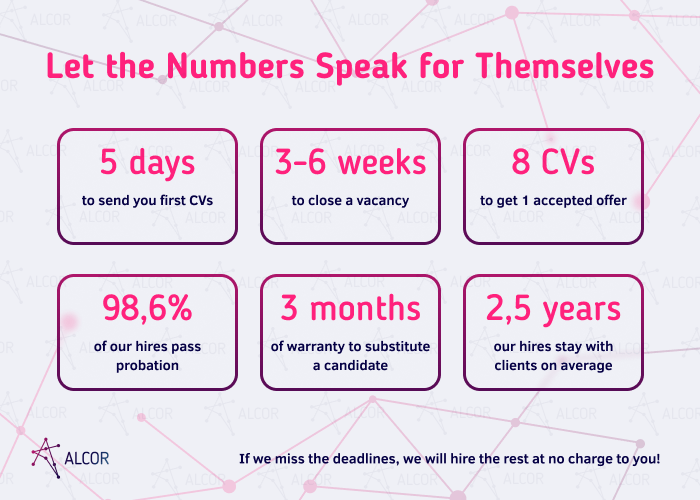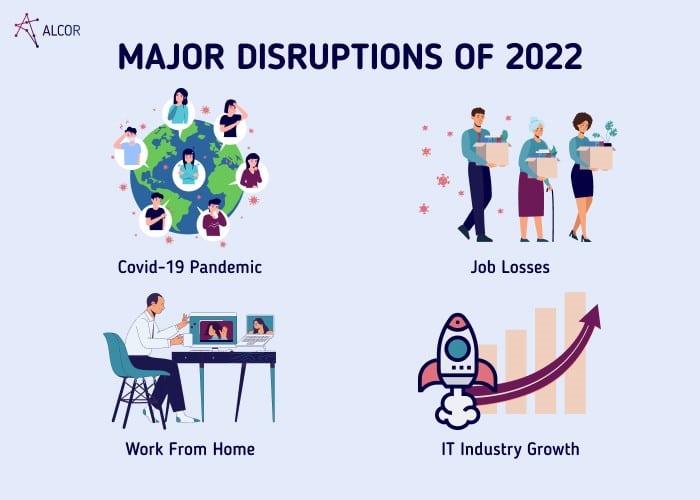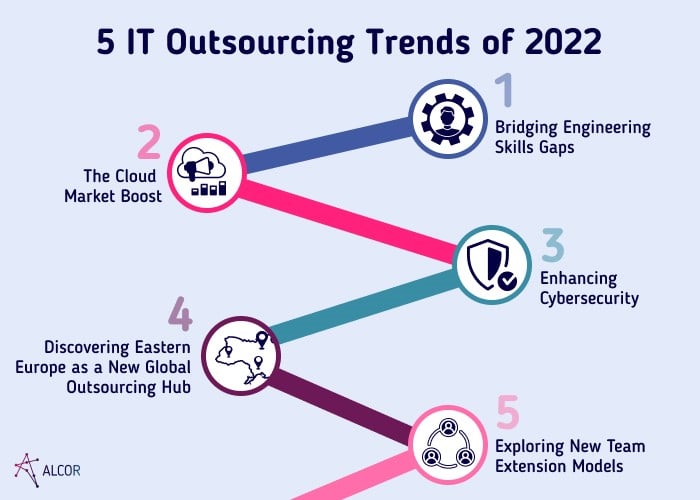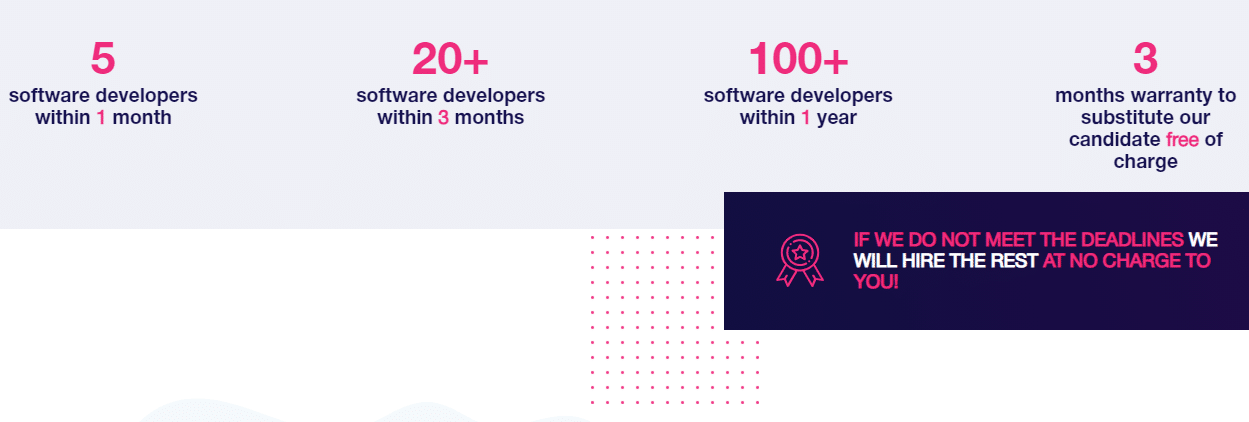IT outsourcing is a staffing solution that involves delegating programming tasks to third-party vendors. Company leaders have been using this business process for years and keep doing so during post-Covid times. They need it to find the right programmers, save costs on in-house hiring and maintenance, and stay flexible when it comes to scalability. But will these reasons keep driving CTOs to outsource IT projects in 2022?
To answer this question, I’ve spent years helping American and European tech product companies to establish their software offices in Ukraine. This let me notice and analyze software development trends that will affect the IT sector in the near future. Today, I’m going to discuss the current trends in IT outsourcing, how you can take advantage of them, and what to do if you need a better alternative to outsourcing.

The Biggest Trend in IT Outsourcing Today
Delegating programming projects to outside providers is a trend in software development that was gaining popularity among tech leaders long before the start of the pandemic. On top of that, they learned how to benefit from it in terms of talent availability and price. Thus, revenue of the IT outsourcing industry alone was over $350 million in 2021 and is expected to reach around $430 million in 4 years.
How has Covid-19 influenced IT outsourcing?
The lockdown has brought major disruptions to the corporate world. Some spheres suffered losses that made 114 million people worldwide lose their jobs in 2020, while other industries like IT outsourcing and offshoring managed to thrive. IT services exports in Ukraine alone reached $5 billion in 2020 – an over 20% increase compared to 2019.
This happened because the IT industry quickly adjusted to the Work-From-Home mode. According to different data, employees who switched to WFH became more satisfied with their jobs and now prefer this perk over a pay raise. Because of the remote, the future of outsourcing for IT and other industries became brighter. Both in-house and offshore teams use the same online conferencing and project management tools. This is the reason why software outsourcing is now even more attractive to startups, SMEs, and large corporations.

5 Newest IT Outsourcing Trends Every CTO Should Consider
Apart from remote work, you need to think about these trends in outsourcing software custom development:
Trend #1: Bridging Engineering Skills Gaps
According to research, the IT functions that lacked engineering skills in 2020 were cybersecurity, change management in organizations, enterprise & technical architecture, and analytics. IT leaders also reported that security, big data, AI, business analysis, development, and project management skills were insufficient on the market. Moreover, the market of AR/VR has increased to about $19 billion in 2020.
Hiring the kinds of programmers that could fill in the above-mentioned skill gaps would become the outsourcing trends of 2021. We can also observe that tech companies are no longer looking so hard for technical skills but also trying to find analytics experts. These professionals track performance and help to achieve automation of business processes.
Since there are not enough engineers on the labor market of many countries, one of the recent trends related to IT outsourcing is hunting talents on foreign emerging markets as effectively as possible.
Trend #2: The Cloud Market Boost
Remote work is impossible without cloud computing. If organizations aim to expand internationally, they need to stop using on-premise servers for data storage purposes. Thus, another trend in outsourcing is shifting to the cloud – public, private, or hybrid.
Last year, it was so widespread that the market size of cloud services grew to $270 billion. Now, cloud computing is gaining momentum and projected to reach the size of around $400 billion by 2022.
Trend #3: Enhancing Cybersecurity
When data is stored on a cloud, it might lack protection from ransomware, breaches, phishing, and other cyberattacks. It’s especially common in public clouds where several companies store their data on the same cloud.
To prevent this, cloud providers are actively investing in security control. But tech leaders are boosting protection themselves by employing one of the top IT outsourcing trends – hiring cybersecurity experts. This will likely increase the cybersecurity market size, which is expected to reach around $180 billion this year.
Trend #4: Discovering Eastern Europe as a New Global Outsourcing Hub
Before the quarantine, one of the main IT outsourcing trends in Europe and the United States was outsourcing IT functions to such Asian countries as India, China, the Philippines, Vietnam, and others. However, not all outsourcing vendors in Asia managed to set up home offices and provide infrastructure for their engineers. This made CTOs look for alternative regions to delegate programming.
That is why organizations switched to Eastern European countries to do IT outsourcing in Poland, Romania, and Ukraine. The main reasons for outsourcing to these countries are big talent pools, lower costs when it comes to developer salaries and taxes, and proximity to Western Europe and Great Britain.
For example, there are over 285,000 developers in Ukraine who have different hard/soft skills and Intermediate or higher levels of English. They stand out because they share similar soft skills and work culture with American and Western European programmers. What is more, Ukrainian engineers work as individual entrepreneurs (like independent contractors in the USA) and pay just 5% of income tax.
Trend #5: Exploring New Team Extension Models
IT outsourcing to Ukraine and other countries fulfills certain company goals. On the other hand, it might result in insufficient dedication from engineers, intellectual property rights infringement, hidden costs, or even a potential loss of internal expertise. Thus, going for alternative employee engagement models is one of the main IT outsourcing future trends.
To be more specific, CTOs in different companies choose outstaffing and R&D offshoring more often. An outstaffing agency can “lend” you one or a team of coders for your project and offers operational management of these specialists. However, outstaffed developers are not interested in long-term maintenance of the product that they develop since they don’t recognize you as their main employer.
Offshoring vendors, on the other hand, are ready to supply you with a whole development branch that may consist of programmers, QA engineers, UI/UX designers, product owners, and others. Besides, offshored developers in Ukraine become a part of your company and are determined to adopt your values and corporate culture. This in turn contributes to productivity and improves development processes.

Are You Looking for Developers to Outsource? We Provide a Turnkey Solution
Alcor is a BPO services provider that can help you build your own R&D center in Ukraine. Beyond that, our solution includes a complete operational back-up: IT recruitment, legal compliance support, payroll and accounting outsourcing, real estate, and other services.
Unlike outsourcing providers, we won’t take control over the engineering team in your offshore development center. Instead, our IT recruitment professionals would gladly attract, hire, and integrate the best programmers on the local tech talent market into your branch in Ukraine.
This is what we did for SBTech, a leading provider of betting solutions and management services to partners across the globe. Before they found our solution, the company had been failing to hire 20 employees via HR outsourcing for an indeterminate amount of time. When the strategy team of SBTech reached out to our BPO company for assistance in IT recruitment, we managed to fill 16 vacancies of the company in just one month.
While SBTech only needed tech recruitment, other companies feel that it’s not enough. That is why they need someone to prepare employment contracts and non-disclosure agreements, plan and pay local taxes, salaries, and follow other offshoring trends for their R&D in the long-term perspective.
For instance, People.ai, a USA-based software product company that develops a machine learning platform for sales among B2B businesses, was one of such companies. They were in need of operational functions and contacted our team to receive them. After that, we established the offshore development office of People.ai in four weeks and recruited more than 25 developers for them. Also, our lawyers completely synchronized our client’s activities for Ukrainian and American laws, while our finance managers took care of payment support.

Final Thoughts
Remote work, supplementing talent shortages, cloud computing adoption, and cybersecurity boost are the future of IT outsourcing. Besides that, more companies keep discovering new regions and countries like Ukraine to outsource programming. Apart from outsourcing, business leaders are opting for alternative staffing models like outstaffing and R&D offshoring.
These IT outsourcing trends will transform the IT industry for good and make companies stick with them for a long time. So, if you plan to not only temporarily outsource or “borrow” developers for a task or project but build dedicated software teams abroad, you should consider setting up your R&D development center in countries like Ukraine.
